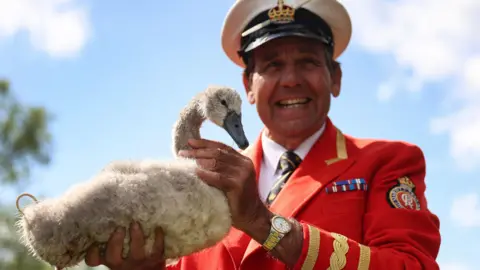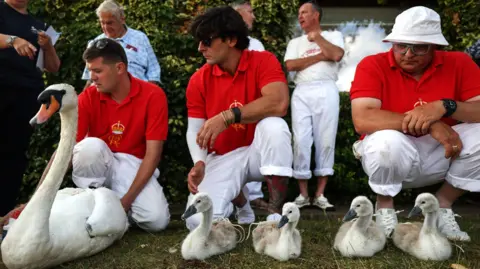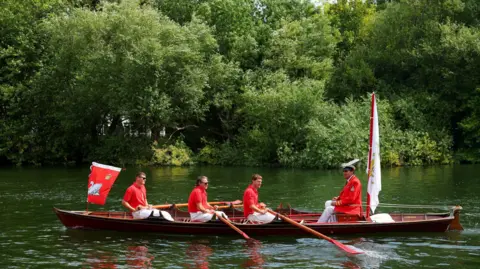Royal correspondent
 EPA
EPASwan numbers have begun to recover on the Thames, after a couple of years of worrying decline, according to an annual royal survey of swans.
A five-day search along the Thames, completed on Friday, found 115 young swans, rather than 86 last year, showing signs that the disappearance of swans could be starting to be reversed.
The traditional count is called “swan upping”, but in recent years it has been more like swan downing, with numbers plunging due to avian flu and human cruelty, including reports of swans being attacked by catapults and air guns.
But the new figures released by the King’s swan marker, David Barber, show a more optimistic picture, after a 45% fall over the past two years.
The tradition of swan upping sees six boats sailing from Sunbury Lock in west London to Abingdon Bridge in Oxfordshire, with the “swan uppers” counting, weighing and giving a health check to young swans found along the way.
The annual event has also become a popular spectacle, with crowds gathering along the riverbank in the sunshine to watch the boats go past, with their colourful flags and crews in ceremonial outfits.
 EPA
EPAThe fall in swan numbers had threatened to make the classic image of swans on the Thames an increasingly rare sight.
But the swan uppers have more positive news about the swan population and will be hoping a corner has been turned – though it’s still down on the 155 counted in 2022.
At the outset of the trip, Mr Barber said he was hoping that avian flu had “eased off”, after a “quite disastrous” impact on the swan population.
“Fortunately, there has been a decrease in reported cases of the disease in the River Thames area in recent months,” said the King’s swan marker.
 Reuters
ReutersWith a swan’s feather in his cap and wearing a scarlet jacket, Mr Barber also spoke of the other risks to swans nesting on the Thames.
He said their search had found swans needing to be cleaned from pollution such as engine oil. Fishing tackle was a longstanding problem and there were attacks from dogs and vandalism from humans.
Swan upping dates back to the 12th Century and was once about counting royal property – with the monarch having ownership of unmarked mute swans swimming on open water.
But is now more about conservation and education, involving schools along the route and helping to teach young people to respect and protect swans.
In particular, Mr Barber wants to discourage young people from the mistreatment of swans – such as shooting them with catapults, which he says causes terrible suffering.
The figures so far show a more hopeful picture for swans on the Thames.


